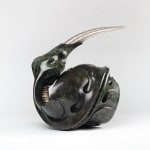Steve Dilworth British, b. 1949
Porpoise - Evolution III, 2004/2005
Bronze and sterling silver
53 x 45 x 45 cm
20 7/8 x 17 3/4 x 17 3/4 in
20 7/8 x 17 3/4 x 17 3/4 in
Unique
Further images
This extraordinary work by Steve Dilworth is cast in bronze with a fully articulated sterling silver vertebrae encased inside. The artist says: 'All thing contain energy. It is self-evident, and...
This extraordinary work by Steve Dilworth is cast in bronze with a fully articulated sterling silver vertebrae encased inside. The artist says: 'All thing contain energy. It is self-evident, and by changing their shape or position you can alter the energy or strengthen it. You end up making power objects and that is ultimately what sculpture is for me. It is not primarily visual art. An artist creates music, art or whatever but it transcends the material. Otherwise it is worthless.'
"Porpoise Evolution III is another work that combines two metals and is the final work in a series of sculptures that focus on evolution.
Shown for the first time together here in London, the series starts with the simple, curved, almost cellular, form of Evolution I which is smooth and irresistably tactile. Evolution II takes on a simple plated carapace which left empty leaves the viewer to ponder what creature it once protected. Skipping a few millenia of evolutionary change Evolution III has developed into an elegant imaginary creature with a fully articulated spine of sterling silver. Originating from the carcass of a porpoise washed up on the rocky beach outside Dilworth’s home, we are invited to look within the work, past the carapace to a precious inner core." - Polly Bielecka
The landscape of eastern Harris is both rugged and beautiful in the extreme, with exposed rock three thousand million years old left by scouring glaciers from the last ice age. The energy and presence of such surroundings are powerfully conveyed in Dilworth’s work, having made the island his home since 1983. Dilworth is renowned for using a vast range of natural materials, mostly found on the island. Indeed, Dilworth used ‘once-living’ objects in his work long before it was fashionable in contemporary art.
The internal and external parts of his sculptures are considered equally – many are containers holding other elements, some visible, some not. His ritualised method of construction adds a shamanistic quality to his work. This primitivist element is almost always present, although some of his elegant formal carvings owe more to a modernist inspiration.
"Porpoise Evolution III is another work that combines two metals and is the final work in a series of sculptures that focus on evolution.
Shown for the first time together here in London, the series starts with the simple, curved, almost cellular, form of Evolution I which is smooth and irresistably tactile. Evolution II takes on a simple plated carapace which left empty leaves the viewer to ponder what creature it once protected. Skipping a few millenia of evolutionary change Evolution III has developed into an elegant imaginary creature with a fully articulated spine of sterling silver. Originating from the carcass of a porpoise washed up on the rocky beach outside Dilworth’s home, we are invited to look within the work, past the carapace to a precious inner core." - Polly Bielecka
The landscape of eastern Harris is both rugged and beautiful in the extreme, with exposed rock three thousand million years old left by scouring glaciers from the last ice age. The energy and presence of such surroundings are powerfully conveyed in Dilworth’s work, having made the island his home since 1983. Dilworth is renowned for using a vast range of natural materials, mostly found on the island. Indeed, Dilworth used ‘once-living’ objects in his work long before it was fashionable in contemporary art.
The internal and external parts of his sculptures are considered equally – many are containers holding other elements, some visible, some not. His ritualised method of construction adds a shamanistic quality to his work. This primitivist element is almost always present, although some of his elegant formal carvings owe more to a modernist inspiration.
Provenance
From the artist.Exhibitions
'Feathers, Bones & Stones', 2022, Pangolin LondonJoin our mailing list
* denotes required fields
We will process the personal data you have supplied in accordance with our privacy policy (available on request). You can unsubscribe or change your preferences at any time by clicking the link in our emails.







